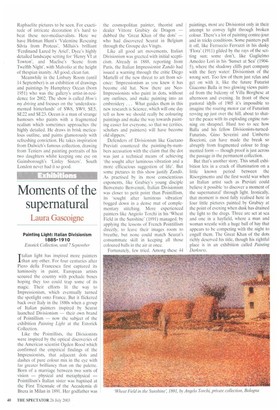Moments of the supernatural
Laura Gascoigne
Painting Light: Italian Divisionism 1885-1910 Estolick Collection, until 7 September
Italian light has inspired more painters than any other. For four centuries after Piero della Francesca first captured its luminosity in paint, European artists scoured the country with pochade boxes hoping they too could trap some of its magic. Their efforts lit the way to Impressionism, which eventually turned the spotlight onto France. But it flickered back over Italy in the 1880s when a group of Italian painters inspired by Seurat launched Divisionism — their own brand of Pointillism — now the subject of the exhibition Painting Light at the Estorick Collection.
Like the Pointillists, the Divisionists were inspired by the optical discoveries of the American scientist Ogden Rood which confirmed the empirical findings of the Impressionists, that adjacent dots and dashes of pure colour mix in the eye with far greater brilliancy than on the palette. Born of a marriage between two sorts of vision — physical and metaphysical — Pointillism's Italian sister was baptised at the First Triennale of the Accademia di Brera in Milan in 1891. Her godfather was the cosmopolitan painter, theorist and dealer Vittore Grubicy de Dragon — dubbed the 'Great Khan of the dots' — who had discovered Seurat in Belgium through the Groupe des Vingts.
Like all good art movements. Italian Divisionism was greeted with initial scepticism. Already in 1888, reporting from Paris, the Italian Impressionist Zande had issued a warning through the critic Diego Martelli of the new threat to art from science: 'Impressionism as you knew it has become old hat. Now there are NeoImpressionists who paint in dots, without any outlines, and make painting into an embroidery , . What guides them in this new research is Science, which will one day tell us how we should really be colouring paintings and make the way towards painting easier for everyone, so that we (critics, scholars and painters) will have become old slippers.'
Defenders of Divisionism like Gaetano Previati countered the painting-by-numbers accusation with the claim that the dot was just a technical means of achieving 'the sought after luminous vibration and a more efficacious suggestion of life'. But some pictures in this show justify Zando. As practised by its most conscientious exponents, like Grubicy's young disciple Benvenuto Benvenuti, Italian Divisionism was closer to petit point than Pointillism, its 'sought after luminous vibration' bogged down in a dense mat of complementary stitching. More experienced painters like Angiolo Torchi in his 'Wheat Field in the Sunshine' (1891) managed, by applying the lessons of French Pointillism directly, to leave their images room to breathe, but none could match Seurat's consummate skill in keeping all those coloured balls in the air at once.
Fortunately, few tried. Among these 44 paintings, most are Divisionist only in their attempt to convey light through broken colour. There's a lot of painting contre-jour and in tricky conditions. Some painters pull it off, like Ferruccio Ferrazzi in his dusky 'Flora' (1911) gilded by the rays of the setting sun; some don't, like Guglielmo Amedeo Lori in his 'Sunset at Sea' (19045), where the shadowy cliffs part company with the fiery water: Divisionism of the wrong sort. Too few of them just relax and get on with it, like the future Futurist Giacomo Balla in two glowing views painted from the balcony of Villa Borghese at afternoon and evening. In front of these pastoral idylls of 1905 it's impossible to imagine the roaring motor car of Futurism revving up just over the hill, about to shatter the peace with its exploding engine running on shrapnel. Hard too to see how Balla and his fellow Divisionists-turnedFuturists, Gino Severini and Umberto Boccioni, can have made the break so abruptly from fragmented colour to fragmented form — though proof is just across the passage in the permanent collection.
But that's another story. This small exhibition lets in a crack of illumination on a little known period between the Risorgimento and the first world war when an Italian artist such as Previati could believe it possible 'to discover a moment of the supernatural through light. Ironically, that moment is most fully realised here in four little pictures painted by Grubicy at the point of evening when dusk has drained the light to the dregs. Three are set at sea and one in a hayfield, where a man and woman wrestle with a huge ball of hay that appears to be competing with the night to engulf them. The Great Khan of the dots richly deserved his title, though his rightful place is in an exhibition called Painting Darkness.


























































 Previous page
Previous page